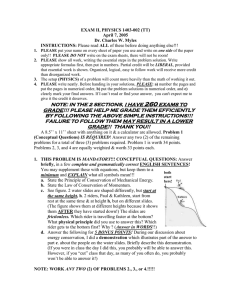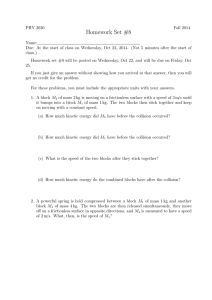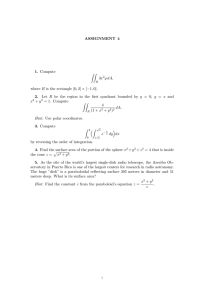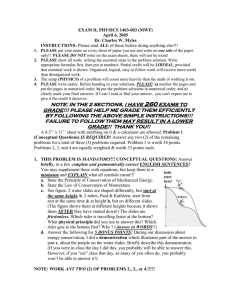EXAM II, PHYSICS 1403 INSTRUCTIONS:
advertisement
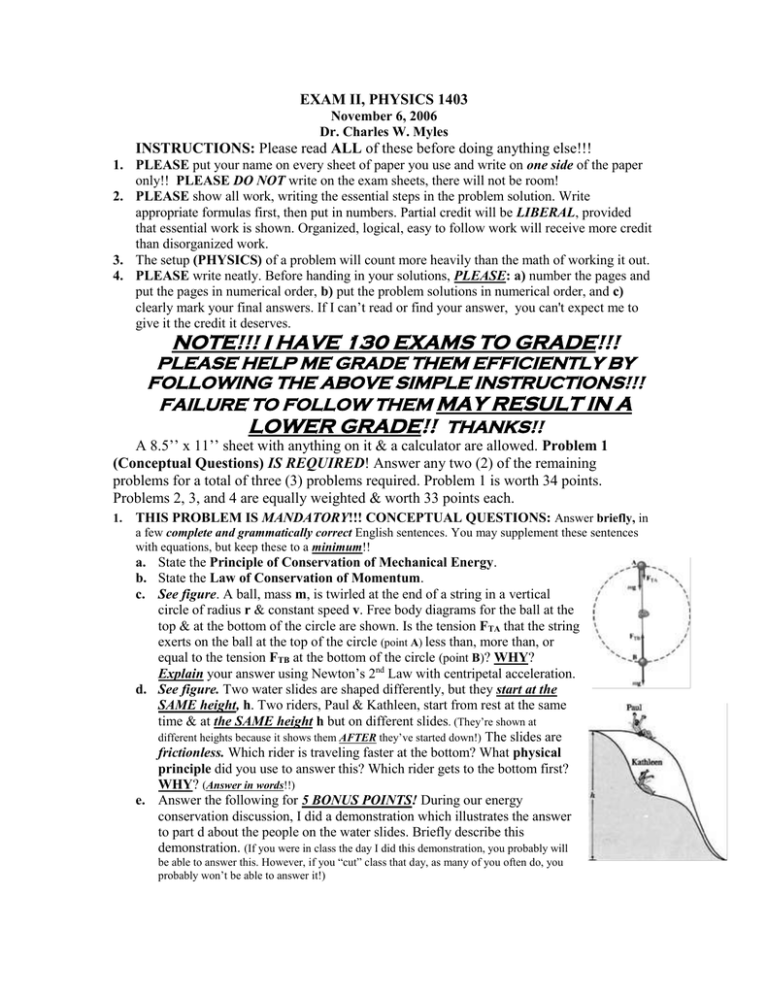
EXAM II, PHYSICS 1403 November 6, 2006 Dr. Charles W. Myles INSTRUCTIONS: Please read ALL of these before doing anything else!!! 1. PLEASE put your name on every sheet of paper you use and write on one side of the paper only!! PLEASE DO NOT write on the exam sheets, there will not be room! 2. PLEASE show all work, writing the essential steps in the problem solution. Write appropriate formulas first, then put in numbers. Partial credit will be LIBERAL, provided that essential work is shown. Organized, logical, easy to follow work will receive more credit than disorganized work. 3. The setup (PHYSICS) of a problem will count more heavily than the math of working it out. 4. PLEASE write neatly. Before handing in your solutions, PLEASE: a) number the pages and put the pages in numerical order, b) put the problem solutions in numerical order, and c) clearly mark your final answers. If I can’t read or find your answer, you can't expect me to give it the credit it deserves. NOTE!!! I HAVE 130 EXAMS TO GRADE!!! PLEASE HELP ME GRADE THEM EFFICIENTLY BY FOLLOWING THE ABOVE SIMPLE INSTRUCTIONS!!! FAILURE TO FOLLOW THEM MAY RESULT IN A LOWER GRADE!! THANKS!! A 8.5’’ x 11’’ sheet with anything on it & a calculator are allowed. Problem 1 (Conceptual Questions) IS REQUIRED! Answer any two (2) of the remaining problems for a total of three (3) problems required. Problem 1 is worth 34 points. Problems 2, 3, and 4 are equally weighted & worth 33 points each. 1. THIS PROBLEM IS MANDATORY!!! CONCEPTUAL QUESTIONS: Answer briefly, in a few complete and grammatically correct English sentences. You may supplement these sentences with equations, but keep these to a minimum!! a. State the Principle of Conservation of Mechanical Energy. b. State the Law of Conservation of Momentum. c. See figure. A ball, mass m, is twirled at the end of a string in a vertical circle of radius r & constant speed v. Free body diagrams for the ball at the top & at the bottom of the circle are shown. Is the tension FTA that the string exerts on the ball at the top of the circle (point A) less than, more than, or equal to the tension FTB at the bottom of the circle (point B)? WHY? Explain your answer using Newton’s 2nd Law with centripetal acceleration. d. See figure. Two water slides are shaped differently, but they start at the SAME height, h. Two riders, Paul & Kathleen, start from rest at the same time & at the SAME height h but on different slides. (They’re shown at different heights because it shows them AFTER they’ve started down!) The slides are frictionless. Which rider is traveling faster at the bottom? What physical principle did you use to answer this? Which rider gets to the bottom first? WHY? (Answer in words!!) e. Answer the following for 5 BONUS POINTS! During our energy conservation discussion, I did a demonstration which illustrates the answer to part d about the people on the water slides. Briefly describe this demonstration. (If you were in class the day I did this demonstration, you probably will be able to answer this. However, if you “cut” class that day, as many of you often do, you probably won’t be able to answer it!) NOTE: Answer any two (2) of problems 2, 3, & 4!!! 2. The figure shows a frictionless track that marbles can be rolled down. The circular loop near the middle has radius R = 0.6 m. The right end of the track rises to height y = 0.5 m. A marble, mass m = 0.2 kg, is put on the track & released from rest at height H at the left of the figure. When it reaches the right end of the track, it’s velocity is v = 4.5 m/s. (Hint: In the following, PLEASE v=? v=0 | marble | Loop H R v=? | remember to take square roots properly!) a. Compute the potential energy, the kinetic energy, & the total mechanical energy of the marble when it reaches the right end of the track. b. Find the potential energy of the marble at the left end of the track & the height H from which it must be released from rest in order to reach the right end of the track with velocity v = 4.5 m/s. c. Compute the potential energy, the kinetic energy, & the velocity of the marble when it has reached the bottom (lowest) part of the track just before it starts onto the loop in the middle. d. Compute the potential energy, the kinetic energy, & the velocity of the marble when it has reached the TOP of the loop. e. What physical principle did you use to do these calculations? 3. 4. v = 4.5 m/s y = 0.5 m v = 15 m/s See figure. A car, mass m = 1600 kg, drives at constant speed v = 15 m/s on a straight road. It passes over a bump of circular cross section. The radius of curvature of the bump is r = 35 m. Neglect the driver’s mass. a. Compute the car’s centripetal acceleration & the “centripetal force” on it when it is at the top of the bump. What is the direction of this r = 35 m acceleration & this force? b. Sketch the free body diagram for the car, properly labeling all forces. Don’t forget the normal force FN on the car due to the road when it’s at the top of the bump. Is there a force in the direction of motion (along the road)? WHY or WHY NOT? c. Write the equation resulting from applying Newton’s 2nd Law to the car at the top of the bump. Writing it in general, without numbers will get more credit than writing it with numbers in! d. Use the equation found in part c to find the normal force on the car at the top of the bump. Is the normal force equal to & opposite to the car’s weight? WHY or WHY NOT? See the figure. Two bumper cars in an amusement park undergo an elastic collision as one approaches the other from behind. The masses are m1 = 485 kg & m2 = 610 kg. The initial velocities are both in the same direction, as in Fig. (a). The initial velocities of m1 & m2 are v1 = 5.2 m/s & v2 = 4.1 m/s. After the collision, the velocities v1´ & v2´ are both still in the same direction, as shown. a. Find the total momentum p1 + p2 of the two cars before the collision. Find the total kinetic energy KE1 + KE2 of the two cars before the collision. b. Compute the total momentum p1´+ p2´ of the two cars after the collision. Compute the total kinetic energy KE1´ + KE2´of the two cars after the collision. (Hint: These can be found WITHOUT knowing the final velocities v1´ & v2´!) What physical principles did you use to find these results? c. Calculate the velocities v1´ & v2´ of the cars after the collision. (Hint: It is NOT possible to answer d. e. this without solving 2 algebraic equations with 2 unknowns!) Compute the impulse that was delivered to m2 by m1. (Hint: In other words, compute the momentum change of m2 due to the collision.) If the collision time was Δt = 8.1 x 10-3 s, use the results of part d to compute the average collision force Fc exerted by m1 on m2. y
